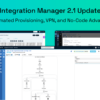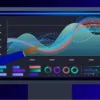We are excited to announce the beta of Integration Hub, a major evolution of our no-code enterprise integration product previously known as Partner Manager.
B2B and Internal Integration in a Single No-Code Tool
Integration Hub significantly expands on the original Partner Manager product’s B2B partner management capabilities and delivers no-code configuring and monitoring for internal integrations. We call this new capability Service Management. Service here refers to a more generalized view of APIs – whereas APIs today generally refer to RESTful Web Services that use HTTP and JSON and are most often synchronous. Services include a variety of message formats (XML, X12, CSV, etc.) and transport protocols (sFTP, Message Queues, etc.), and are often asynchronous.
Improved Message Routing Capabilities
An important feature of Integration Hub is its ability to configure flexible content-based routing between external B2B partners and internal applications without code. This creates a natural connection between B2B integrations and your back-end API-led architecture, allowing you to easily transform and route B2B transactions to and from your re-usable enterprise APIs. It also allows a natural division of labor between the business analysts who generally handle B2B integrations and the developers who create the APIs.
Multi-Routing
Integration Hub extends this content-based routing capability to support multi-routing, where a single message can be routed to multiple partners or applications. A sample use case is back-office integration, in which an event in the ERP, such as approval of a purchase order request, needs to update internal systems (such as your CRM) as well as the external partner who made the request.
Batching and Debatching
Integration Hub extends our no-code support for configuring complex batching and debatching scenarios using the browser. Debatching is a common task in B2B scenarios where a partner sends multiple transactions in a single file, but back-end systems require individual messages:
Integration Hub enables the task of configuring the splitting of such batches to be done by an analyst, in the browser:
Improved Monitoring
We’ve made significant improvements in our transaction monitoring screens to support navigation of the complex graph of transactions that can come up when using batching/debatching and advanced multi-route scenarios. For example, in this screen we see an instance of an outbound integration where a single outbound message matches multiple routes, one of which goes out to a partner:
When you select the transaction route to the partner, you are able to see the context of the larger integration and have links to either navigate backward to the initiating transaction, or forward to the chained transaction that maps to the partner’s format and delivers to their endpoint:
Improved Usability
With the launch of the Integration Hub, we’ve added a number of usability enhancements based on customer feedback.
Organization of Integration Artifacts to Maximize Re-use
Like Partner Manager, Integration Hub supports re-use of as many artifacts as possible between different integrations. For example, if you are able to use the same message structure between several partners, you can create a single Document Type and a single Map and share it across all the partners. This greatly reduces the effort to create new integrations.
In Integration Hub we’ve added the ability to specify, for each artifact, whether it is used in:
- A specific relationship between two actors (partners or applications.)
- All relationships with a particular actor (partner or application.)
- All applications and partners in the enterprise.
This level of control over the scope of re-use allows you to choose between two common enterprise integration re-use models:
- Canonical model – assumes you have a single definition of each message type across your entire enterprise.
- Domain-driven model – allows you to carve out different domains for re-use. For example, your ERP and CRM might each have different data requirements for a message type of the same name.
Navigation
Single Screen for all Partners and Applications
A common user request is to eliminate the need to navigate into and out of a specific relationship in order to view the various artifacts. We’ve evolved the UI model to be a single view across all relationships with the ability to quickly change the filter without having to navigate out of one partnership and into another.
All Artifacts View
Another common request is the ability to see different types of artifacts (Document Types, Maps, Endpoints, Channels, and Transactions) within a relationship in the same view:
Transaction Designer Enhancements
Icons Representing Partners/Applications
We’ve added icons on the left and right side of the Transaction Designer to make it easier to specify and view at a glance the direction of a particular transaction.
Quick View
We’ve also enhanced the Quick View and made it the default so it’s easier to see the primary aspects of an end-to-end transaction in a single screen without scrolling.
Validation
We’ve improved the validation for all data entry screens. This new validation automatically detects what the requirements for fields are and shows you these requirements as you begin to fill out a field. As you meet these requirements, Integration Hub checks them off one-by-one so you can know what you are missing. If you get something wrong, we will visually alert you to your mistake so you can quickly correct it.
Interested in the Beta? Let us know.






